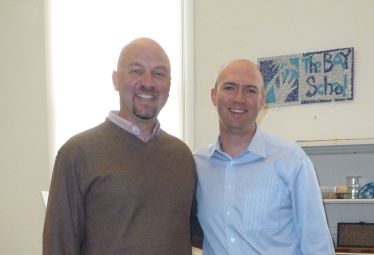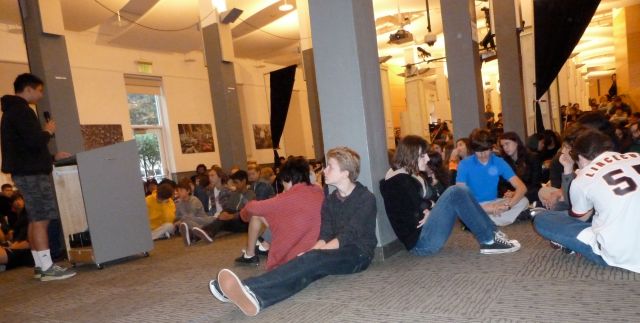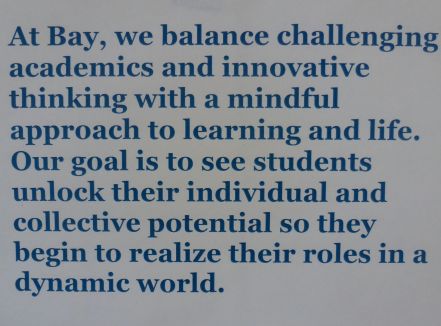Every so often a sweet little synchronicity opens doors of exploration. Just this past week, one such moment led me to a small school intertwining themes of mindfulness and mindset, right here in San Francisco.
After another fine improv show at Bay Area Theatersports (BATS) last Sunday, I complimented Katherine Riley, one of the performers, on the work she and her teammates had done. We got to chatting a bit and when I told her that I was from Massachusetts, she asked which city. “Oh, you likely won’t have heard of it,” I replied. “It’s just a little town called Northfield.”
“Is that where Northfield Mount Hermon is?”, she asked in return.
I laughed and said, “Yes, that’s where I work.”
“Oh, yeah,” she said. “My boss used to work there.” Turns out, Andy Shaw, a former colleague of mine who had entered NMH the same year I did, is now Academic Dean at the Bay School, an independent college prep program in the Presidio. As she and I dug further into the coincidence, we realized that we both taught religious studies and that two of the main themes for my sabbatical—contemplative practice and the growth mindset—had become integral parts of their school philosophy. “Oh, you should definitely come visit while you’re here,” Katherine suggested. I didn’t take long to accept the invite.
Like so many of the forward-thinking non-profits that have come to fill the Presidio since its conversion from military use, the Bay School was conceived as an alternative to mainstream education. The school’s founders—a group of Bay Area educators, community leaders, and parents—wanted to help prepare their students not only for college but also for courageous leadership in an ever-more-connected, quickly-changing world. That meant developing traditional technical and scientific skills in combination with a savvy understanding of comparative religions and wider multiculturalism. The first head of school was an Episcopal priest and the first chaplain a Buddhist nun; together they helped instill a non-secular, mindfulness-based ethic throughout the program. Today, with the school population up to about 325 students and 62 faculty and staff, those commitments show up in a number of ways.
Most immediately, all school members gather in one Great Room for a community meeting each morning. As part of that time together, they share five minutes of silent mindfulness meditation. The kids settle quickly into comfortable, spine-lengthening positions and sit with their eyes closed or relaxedly focused on some neutral point in their field of vision. As remarkable as it seemed to me, the stillness appeared quite normal to them. They finished up their five minutes, all stood together, and took one last shared breath before heading off with a blessing for the rest of the day. Breathe in, breathe out. On we go.
When I visited Katherine’s Religion and U.S. Politics class in the afternoon, I asked her students how they felt about the school’s approach to mindfulness. “I appreciate the chance to clear my mind before getting into classes,” said one. “It really helps me actually get myself here.” Another talked about the way the practice had become a part of her life: “At first, I thought it was a bit weird, but now I see how it affects me everywhere. I just feel calmer and more focused.” In a chicken-or-the-egg way, I couldn’t tell if the school had attracted mindful students or had developed them—most likely, they had engendered a mutally reinforcing combination of both—but the effect seemed clear either way. These kids are kind.
There seemed to be no adversarial relationship towards the adults in the community. “Our teachers are cool people,” one young man offered. “They hold us accountable when we do stupid stuff, but we figure out the consequences together.” And I couldn’t spot any real cliques among the student body. “It’s not that we don’t have groups,” reckoned Ian, a remarkably articulate junior, “but that their boundaries are fluid. You move between the groups if you want to.” When I asked if that meant that the groups didn’t have walls, he continued by saying “Yeah, it’s not a wall. It’s more like a line in the sand that says ‘This is who we are. If you want to join us, you can.’ There’s not really people looking down on anyone else. The juniors and seniors look out for the underclassmen.” Each person I spoke with had an affection for the place without any accompanying arrogance or overweening pride.
I found the school’s approach to discipline especially notable. So many schools set their systems with a logic based on commands, rules, and expectations, most of which get framed in the negative. Do not use drugs or alcohol. Do not harass or haze another. Do not cheat or plagiarize. Such codes ask students to set their behavior based on an external standard, what someone else has dictated for them. They require compliance rather than asking for commitment. In short, they go with ‘Thou shalt not.’ [1] The Bay School’s Guiding Precepts take a different tack:
We aspire to live by these guiding precepts and to build our community life on them.
- We value living with kindness and honesty; we are careful truth tellers.
- We value the importance of boundaries; we take only what is given.
- We value respecting ourselves and our friends in relationship; we don’t misuse sexuality.
- We value a clear mind and a healthy, strong body; we don’t intoxicate ourselves with alcohol, drugs, unhealthy food, or the misuse of technology.
- We value kind speech; we don’t slander or gossip.
- We value the richness of difference and diversity; we don’t praise ourselves at the expense of another; we don’t bully or haze.
- We value communication; we don’t harbor anger or ill will, especially toward ourselves.
- We value generosity; we share, giving and receiving help.
- We value patience with ourselves and others; we don’t rush to judgment.
- We value the earth, our home; we don’t pollute, we recycle and we are careful, conscious consumers.
- We care about our growth and maturity. We want our school to be a safe, kind and respectful environment, a place where we can make mistakes, learn from them and grow. We join with the entire Bay School community in committing ourselves to be mindful of these precepts in our daily lives, in our choices, and in our relationships.
With this language of values and aspirations, kids learn general principles rather than dictates or demands. Living the precepts then becomes an ongoing practice, one that requires regular attention and active work. Adolescent temptations become catalysts for personal growth and the resultant ethical inquiry draws their commitment even deeper—How do we live out this value? How do we express our care? Initiated through invitation and strengthened by affirmation, the precepts magnetize students toward a whole array of positive choices. They call out the best of who kids can be and become—and the do the same for the adults.
Given these values, it didn’t surprise me that the Bay School also embraces a growth mindset. First-year students learn about Carol Dweck’s work and find those lessons reinforced throughout the curriculum. Teachers get and preach that seeming failure often leads in the direction of success and, as a result, students develop a more graceful approach to setbacks. As I watched the kids in their classes and moving about their day, I saw no evidence of anyone having to prove themselves. I saw and heard plenty evidence of students wanting to improve themselves.
For sure, it’s much easier for a newer, smaller school to maintain these approaches. Many of the Bay School faculty have been on board from the beginning and no dusty traditions got in the way of adopting such language. Larger schools have to wrestle with completely different levels of complexity and liability, significant weights that hamper any desire for nimble nuance. And I know that no discipline system, no matter how careful or positively framed, reaches perfection. Still, none of that makes what the Bay School’s doing any less awesome. I love knowing that these students and teachers are out here in the Presidio, lighting a Golden Gate lamp of mindfulness to inspire the rest of us. I’m thankful for the small synchronicity that led me to their door.
[1] NMH, where I teach, has a mixed approach on this count. Some of our school rules employ the negative (“Do not endanger yourself or others.”) while others choose a positive frame (“Be a positive and cooperative member of the community.”). Our school handbook includes a noble Statement of Personal Commitment that we ask students to make: By becoming a member of the NMH community, I agree to abide by the school’s standards, policies and procedures. On my honor, I will conduct myself according to the highest standards of integrity in all areas of school life, and I will treat others with honesty, civility, and respect. Good stuff.
Unfortunately, we dilute that sentiment with what follows immediately after: Each student in the NMH community will be expected to sign and comply with the above. As a commitment, the statement would lead desired behavior from the inside. As a dictate to be complied with, it imposes an expectation from the outside. Such language differences may seem subtle but they make a huge difference in both tone and investment.






Thanks for visiting, Ted! If we inspired you half as much during your visit as you inspired me during our conversation, then it was worth the trip!